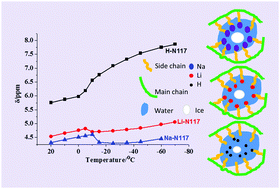A broad-range variable-temperature solid state NMR spectral and relaxation investigation of the water state in Nafion 117†
Abstract
Understanding the water state in Nafion is not only crucial for operating a proton-exchange membrane (PEM)-based fuel cell, but also intimately related to the elucidation of the proton transport mechanism in a PEM. Although many studies have been published on this subject, some controversies and ambiguities remain unresolved. In this work, we design three different types of Nafion samples by substituting protons with lithium or sodium cations. We also pay special attention to the preparation of samples for carrying out broad-range variable temperature solid state NMR experiments so that no membrane dehydration occurs during the long experimental time at low temperatures. With these precautions and improvements, clear and largely straightforward information could be obtained to ensure minimal ambiguity and complexity in the interpretation of the experimental data. Our results show that about 40–60% of water remains unfrozen at −70 °C, depending on the type of the substituting cation. Both the 1H and 2H spectral and relaxation results indicate that water freezing starts from the center of the nanopores inside Nafion and increases gradually as the temperature decreases. The protons remain dissociated with sulfonate groups even at the lowest temperature we reached (−70 °C), whereas both lithium and sodium are associated with sulfonate groups at most temperatures below 0 °C. The experimental data also suggest that besides frozen and unfrozen water, there is broad distribution of water state and dynamics in Nafion as the temperature is lowered from above zero down to −70 °C. The effect of the size of the substituting cation significantly affects the properties of supercooled water by modifying the cation–water interaction and impeding the rotation of sulfonate groups. These novel results not only help us in establishing a better understanding of the water state in Nafion and its performance as a proton exchange mebrane, but also provide insights into water freezing, antifreeze and supercooling in other nanoscopic environments.



 Please wait while we load your content...
Please wait while we load your content...